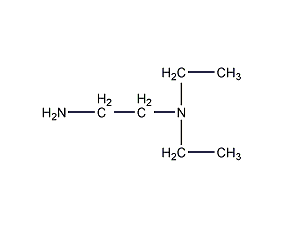
Structural formula
| Business number | 02HQ |
|---|---|
| Molecular formula | C6H16N2 |
| Molecular weight | 116.21 |
| label |
N,N-diethylethylenediamine, N,N-diethylethylenediamine, 2-diethylaminoethylamine, N,N-diethyl-1,2-ethylenediamine, Diethylethylenediamine, (2-diethylamino)ethylamine, (C2H5)2NCH2CH2NH2, DEAEA, (Diethylamino)ethylamine, beta-Diethylaminoethylamine, 1-Amino-2-(diethylamino)ethane, 2-(Diethylamino)ethylamine, 2-Aminoethyldiethylamine, N,N-Diethylethylenediamine, N,N-Diethyl-1,2-ethanediamine |
Numbering system
CAS number:100-36-7
MDL number:MFCD00008176
EINECS number:202-844-7
RTECS number:KV3500000
BRN number:605299
PubChem ID:None
Physical property data
1. Properties: colorless liquid.
2. Density (g/mL, 20℃): 0.82
3. Relative vapor density (g/mL, air=1): 4.00
4. Melting point (ºC): <-70
5. Boiling point (ºC, normal pressure): 145.2
6. Boiling point (ºC, 3mmHg): Undetermined
7. Refractive index: 1.436
8. Flash point (ºC): 46.1
9. Specific rotation (º): Undetermined
10. Autoignition point or ignition temperature (ºC): Not determined
11. Vapor pressure (mmHg, 20ºC): Not determined
12. Saturated vapor pressure (kPa, ºC) : Undetermined
13. Heat of combustion (KJ/mol): Undetermined
14. Critical temperature (ºC): Undetermined
15. Critical pressure (KPa): Undetermined
16. Log value of oil-water (octanol/water) partition coefficient: Undetermined
17. Explosion upper limit (%, V/V): Undetermined Determined
18. Lower explosion limit (%, V/V): Undetermined
19. Solubility: Miscible with water.
Toxicological data
Acute toxicity: rat oral LD50: 2830mg/kg; mouse peritoneal cavity LD50: 300mg/kg; rabbit skin contact LD50: 820μL/kg;
Ecological data
This substance is slightly hazardous to water.
Molecular structure data
1. Molar refractive index: 37.10
2. Molar volume (cm3/mol): 138.5
3. Isotonic specific volume (90.2K ): 325.5
4. Surface tension (dyne/cm): 30.5
5. Dielectric constant:
6. Dipole moment (10-24cm3):
7. Polarizability: 14.70
Compute chemical data
1. Reference value for hydrophobic parameter calculation (XlogP): None
2. Number of hydrogen bond donors: 1
3. Number of hydrogen bond acceptors: 2
4. Number of rotatable chemical bonds: 4
5. Number of tautomers: none
6. Topological molecule polar surface area 29.3
7. Number of heavy atoms: 8
8. Surface charge: 0
9. Complexity: 41.8
10. Number of isotope atoms: 0
11. Determine the number of atomic stereocenters: 0
12. Uncertain number of atomic stereocenters: 0
13. Determine the number of chemical bond stereocenters: 0
14. Number of uncertain chemical bond stereocenters: 0
15. Number of covalent bond units: 1
Properties and stability
Avoid contact with strong oxidants and acids.
Storage method
Store in a cool, ventilated warehouse. Keep away from fire and heat sources. The storage temperature should not exceed 30℃. They should be stored separately from oxidants and acids, and avoid mixed storage. Use explosion-proof lighting and ventilation facilities. It is prohibited to use mechanical equipment and tools that are prone to sparks. The storage area should be equipped with emergency release equipment and suitable containment materials.
Synthesis method
It is obtained by hydrolysis, addition and degradation of acrylonitrile; another production method is to obtain this product by hydrogenating ethylenediaminoacetonitrile.
Purpose
It is used in medicine to synthesize procainamide hydrochloride, chloroprocaine hydrochloride, cinchaine hydrochloride, and tiapride hydrochloride. Used as an intermediate in organic synthesis.

 微信扫一扫打赏
微信扫一扫打赏

